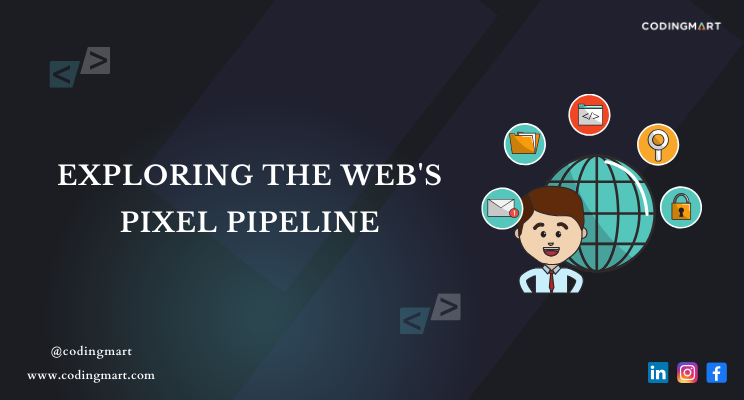blogs
Enhancing User Experience: Mastering the Web's Pixel Pipeline

Hey Technophiles,
In the fast-paced world of web development, user expectations for interactive and seamless experiences have never been higher. Today’s users demand not only quick page loading times but also responsive interactions throughout the entire user journey. The Interaction to Next Paint (INP) metric plays a pivotal role in gauging the user experience, emphasizing the importance of consistent and reliable responsiveness to user needs.
Delving into the intricacies of crafting pages that respond promptly to user interactions involves a profound understanding of how HTML, JavaScript, and CSS are handled by browsers. This journey requires ensuring that your code, along with any third-party code, operates efficiently to create a user experience that feels fast and dependable.
The Challenge of Meeting Refresh Rates:
Most modern devices refresh their screens at a rate of 60 times per second, equating to 16.66 milliseconds per frame. However, the browser’s overhead further limits the time available for executing tasks to 10 milliseconds per frame. Failure to stay within this budget results in a drop in frame rate, leading to on-screen juddering—a phenomenon commonly referred to as “jank.”
Tailoring Performance Targets:
Meeting the 10-millisecond threshold is crucial for animations, where objects’ positions are interpolated across frames. However, for discrete changes in the user interface without motion in between, achieving such changes within 100 milliseconds is recommended. The INP metric’s “good” threshold, set at 200 milliseconds or lower, accommodates a diverse range of devices with varying capabilities.
The Pixel Pipeline Unveiled:
To excel as a web developer, understanding the browser’s pixel pipeline is essential. The five major areas—JavaScript, Style Calculations, Layout, Paint, and Composite—play a critical role in determining the efficiency of your code. Whether it’s handling visual changes through JavaScript or utilizing CSS animations and transitions, comprehending the intricacies of the pixel pipeline is vital.
- JavaScript: JavaScript is typically used to handle work that will result in visual changes to the user interface. For example, this could be jQuery’s animate function, sorting a dataset, or adding DOM elements to the page. JavaScript isn’t strictly necessary to trigger visual changes, though: CSS animations, CSS transitions, and the Web Animations API are capable of animating page contents.
- Style calculations: This is the process of figuring out which CSS rules apply to which HTML elements based on matching selectors. For example, .headline is an example of a CSS selector that applies to any HTML element with a class attribute value that contains a class of headline. From there, once rules are known, they are applied, and the final styles for each element are calculated.
- Layout: Once the browser knows which rules apply to an element it can begin to calculate the geometry of the page, such as how much space elements take up, and where they appear on the screen. The web’s layout model means that one element can affect others. For example, the width of the <body> element typically affects the dimensions of its child elements all the way up and down the tree, so the process can be quite involved for the browser.
- Paint: Painting is the process of filling in pixels. It involves drawing out text, colors, images, borders, shadows, and essentially every visual aspect of the elements after their layout on the page has been calculated. The drawing is typically done onto multiple surfaces, often called layers.
- Composite: Since the parts of the page were potentially drawn onto multiple layers, they need to be applied to the screen in the correct order so that the page renders as expected. This is especially important for elements that overlap another, since a mistake could result in one element appearing over the top of another incorrectly.
Each of these parts of the pixel pipeline represents an opportunity to introduce jank in animations, or delay the painting of frames even for discrete visual changes to the user interface. It’s therefore important to understand exactly which parts of the pipeline your code triggers, and to investigate if you can limit your changes to only the parts of the pixel pipeline that are necessary to render them.
Unraveling the Pixel Pipeline:
The pixel pipeline involves JavaScript for visual changes, style calculations to determine applicable CSS rules, layout for page geometry, paint for filling in pixels, and composite for rendering elements in the correct order. Each step introduces opportunities for introducing jank in animations or delaying frame painting, emphasizing the need to tailor your code to trigger only the necessary parts of the pixel pipeline.
Rasterization: A Critical Component:
Painting involves two tasks: creating a list of draw calls and filling in pixels. The latter, known as rasterization, is crucial for understanding the rendering process. While you won’t always touch every part of the pipeline on every frame, knowing which parts your code triggers is key to optimizing performance.
Whether your goal is seamless animations or instant visual changes in the user interface, a deep understanding of the browser’s pixel pipeline is indispensable. By navigating the complexities of JavaScript, style calculations, layout, paint, and composite, you can elevate your web development skills and deliver user experiences that meet the high expectations of today’s web users.